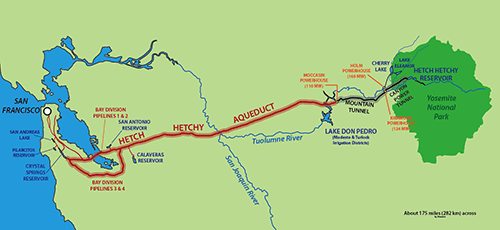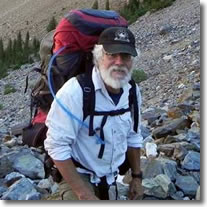Welcome to the Journal of Sierra Nevada History & Biography
David Kuchera and Jay Hester, Editors
Hetch Hetchy Restored?
In early October 2013, more than 20 people from various professions and walks of life met at the offices of Heyday in Berkeley, California. They were invited guests of publisher Malcolm Margolin. They were newspaper people, university professors, national park managers, conservationists, free-lance writers and other enthusiasts. Representing the Sierra College Press were Rick Heide and myself. We counted ourselves lucky to be included in this heady meeting. It was not a new idea, but various forces had elevated this issue in all of our minds over the previous years—and a meeting was called.
Sierra College Press is very proud and pleased to have already engaged in a multi-year publishing partnership with Heyday. We have recently reaffirmed our partnership with another five-year Memorandum of Understanding. Earlier, we had been asked to advise author Ken Brower and Heyday as they developed the Hetch Hetchy book (which we eagerly did).
We found this Hetch Hetchy issue one of great significance and one that would certainly be of interest to our e-Journal readers. Our Mission Statement includes “…disseminating ideas, knowledge, and academic scholarship of value concerning the Sierra Nevada region.” Hetch Hetchy, then, clearly fit within this statement and resided snugly within the geographic heart of the very Sierra Nevada region that our press represents. Having John Muir’s feisty great-great-grandson, Robert Hanna, on our board kept this issue’s coals burning in our minds.
At the meeting the energetic crowd discussed a single topic, one near and dear to them all. That is the potential resurrection and restoration of Yosemite’s Hetch Hetchy Valley—drowned for more than 80 years behind O’Shaughnessy Dam within a National Park. The meeting occurred very near to the hundredth anniversary of the 1913 Raker Act, the congressional bill that dealt the death knell to a beloved Yosemite Valley “twin.” It also coincided with the publication of Heyday’s new book, Hetch Hetchy: Undoing a Great American Mistake by author Kenneth Brower. Heyday’s meeting room buzzed with excitement and good cheer while Margolin welcomed his guests and described why he had hosted this discussion.
 Malcolm admitted the Brower book was a straight-out, unapologetic advocacy piece, with a clear and forceful message: “take the dam down and restore the Valley to splendor.” He set the content and tone of the evening. He had fully intended to engage his guests in a thorough brainstorming on the issue of whether or not restoration of Hetch Hetchy was politically, economically, or even philosophically realistic. All thoughts were welcomed, regardless of how pragmatic or delusional. Hours of discussion resulted in thoughtful and sincere contributions. Integrity abounded as arguments for and against restoration were discussed with equal and welcome fullness—all requiring serious consideration and truthful responses. In a letter to his guests the following week, Malcolm wrote, “I hope that the thoughts of the evening help us all develop a way of approaching the issue that embraces rather than denies its complexity and that not only restores ecological integrity to the Valley but at the same time nourishes the intellectual and moral integrity with which we think about it.”
Malcolm admitted the Brower book was a straight-out, unapologetic advocacy piece, with a clear and forceful message: “take the dam down and restore the Valley to splendor.” He set the content and tone of the evening. He had fully intended to engage his guests in a thorough brainstorming on the issue of whether or not restoration of Hetch Hetchy was politically, economically, or even philosophically realistic. All thoughts were welcomed, regardless of how pragmatic or delusional. Hours of discussion resulted in thoughtful and sincere contributions. Integrity abounded as arguments for and against restoration were discussed with equal and welcome fullness—all requiring serious consideration and truthful responses. In a letter to his guests the following week, Malcolm wrote, “I hope that the thoughts of the evening help us all develop a way of approaching the issue that embraces rather than denies its complexity and that not only restores ecological integrity to the Valley but at the same time nourishes the intellectual and moral integrity with which we think about it.”
This was not a random list of invitees—all were well aware of Heyday’s interest and all were knowledgeable about the issue. No water or power officials were invited. There was no need for them. Their succinct will-not-budge hard-line perspectives were well-known—clearly and abundantly stated for the record. Invitees, however, included many San Franciscans and citizens of municipalities within the Bay Area who were direct beneficiaries of the water and power that comes from the Hetch Hetchy project. They knew very well what enormous resistance existed to even a discussion of the potential restoration.
The group, in other words, was assembled to rethink the restoration issue and, perhaps, to recommend alternative strategies after a failed 2012 Measure F campaign in San Francisco (more on this in the upcoming articles in this e-Journal).
In another communication, Margolin had penned, “If the great work of the last century was re-engineering Nature, the great work of the current era is clearly to repair some of the damage caused, restore natural areas wherever possible, and establish a sustainable and spiritually nourishing relationship with the land. This is our vision, our calling, the crusade of our times. We need to get on with it, and to do so I feel we can draw on part of the legacy of Hetch Hetchy—work on restoring this splendid Valley with something of the sense of confidence, courage, and bigness of vision that inspired those who built the dam in the first place.”

We were in full realization that this Hetch Hetchy issue, or any discussion about it, would be treading on political thin ice. We chose to explore it from a wider array of perspectives, using our own Sierra College scholars as well as inviting in other authors who would shed new light on this old issue.
Why would we reopen this “can of worms?” Well, for many reasons. Any significant historic event that occurred in the Sierra’s past, that, for all intents and purposes, spawned the modern conservation movement, took place in the home of California’s favorite son, John Muir, and violated the sanctity of the preservation of California’s first National Park, deserves plenty of attention. To add to this, a century has passed since the project was authorized, and the issue is still on the minds of thousands of people across the nation.
The Raker Act (authorizing a dam on the Tuolumne River within Yosemite National Park) was signed in 1913. Last year (2014) marked the 100th anniversary of John Muir’s death and the 150th anniversary of the beginnings of the “preserved park idea”—one that spawned both the California State Parks and the National Parks ideas. Next year (2016) will mark the centennial of the National Park Service and the system that was created, in part, to see that violations like the Hetch Hetchy water project do not occur again within preserved and protected areas.
Times have changed and attitudes have also evolved. Water storage and delivery methods and strategies have become much more conscious of their negative impacts to the environment. Powerful computers can be used to question and test previously utilized water management systems. The fledgling National Park Service has grown immensely—it now manages 59 National Parks and about 500 other units. The very idea of damming a free-flowing river and converting a fully-functional mountain meadow ecosystem, within a National Park, to a reservoir owned and managed by a distant municipality would, quite frankly, never make it “past first base” in today’s greener gestalt.
For these, and many other reasons, the Sierra College Press decided that the Hetch Hetchy issue was far from over—and we decided to explore the issue even further. We cooperated with Heyday to conduct numerous events and exhibits. We held seminars and invited speakers. As we collected more and more information, we decided to add Hetch Hetchy to our long list of e-Journal topics.
Even in the Drought
Now, in 2015, as California enters what is expected to be the fourth year of a prolonged drought, is this Hetch Hetchy issue worth examining? We think so. The restoration of Hetch Hetchy will, most likely, eventually happen. While San Franciscans and Bay Area users of Hetch Hetchy water and power have dug their heels deep into the sand on this issue, the fact remains that the project was, and still is a flagrant violation of the very principles upon which National Parks were established.
The realities of climate change, human overpopulation, resource depletion, unchecked pollution, natural ecosystem conversion, and the decimation of biological diversity are undeniably upon us. In an attempt to thwart or subdue the negative effects of such realities, some of the world’s most creative minds, from all around the globe, are designing and creating solutions—from simple behavioral modifications to complex technical advances—that address each of these pressing issues.
We know, without question, that we are 100% dependent upon our environment. We also know that this dependency requires our close attention to the principals of sustainability. A large part of the solution to unsustainable activities depends on the well-known R’s. Besides the older (but still important) “reduce, reuse, recycle”, we now add “rethink” and “restore” and even “refuse.”
The restoration of naturally functioning ecosystems will be an essential component of our collective efforts to return to sustainable societies (and sustainable economies). The decommissioning of dams is not only about the removal of fish-passage barriers. While the return of anadromous fish to the Elwha River is thrilling and heartwarming, this is only one component of the total benefits package of the dismantling of the Elwha River dams.
Similarly, the restoration of the Hetch Hetchy Valley ecosystem, in time, will provide similar broad-spectrum positive results. Eventually, fully-functional terrestrial and aquatic ecosystems will thrive—providing additional oxygen and sequestering troublesome carbon dioxide. Ecosystem services will abound—and Hetch Hetchy will become much more than just another Yosemite twin. The Valley will thrive. And so will its new inhabitants, wild and human alike. New earth will grow and transform—all the while as San Franciscans and Bay Area citizens continue to have their needed water and power resources. If done correctly, there will be no losers—only winners.
So, with these thoughts in mind, and the willingness of numerous authors to contribute to this lengthy e-Journal, we offer many hopeful thoughts to our readership. This may be the most ambitious e-Journal that we’ve done to date and, as far as we know, this is the most wide-ranging and comprehensive collection of Hetch Hetchy articles that has appeared in print in the nine decades since O’Shaughnessy Dam was built.
Contributors
Robert (Muir) Hanna was only too happy to pen the preface to this thought-provoking collection of articles. California historian David Kuchera was invited to provide an overview of California water engineering and its effects on the environment. Anthropologist Bruce Pierini would provide a thumbnail sketch of Native Americans and their plight in Hetch Hetchy and the Yosemite region. I wrote an article describing the pre-dam natural history of Hetch Hetchy. Author and editor Rick Heide was asked to reach further back into San Francisco’s history to examine the city’s historic interests in freshwater acquisition.
Philosopher and environmental ethicist Vernon Martin contributed thoughts on the ethics of damming the Tuolumne River in Yosemite and how the restoration of Hetch Hetchy might be viewed, should it occur. Professor Sarah Null (who did pioneering work on the feasibility of rerouting the water stored behind O’Shaughnessy Dam) summarized her work under Professor Jay Lund while at UC Davis, illustrating the real possibility of storing San Francisco’s water downstream from, and outside the boundary of, Yosemite National Park. Water specialist Spreck Rosekrans added to this plausibility by describing the “how it can be done” engineering component of this complex equation.
Biologist/professor Jennifer Skillen added two articles on the technical aspects of dams, as well how post-flooding revegetation occurs, with, and without human intervention. As usual, issues of this magnitude involve powerful politics, and Rick Heide rose eagerly to this challenge. He researched and summarized the current (post-2000) political scene and speculated on this critical component. Politics—and the lack of a larger public movement to pressure political leaders—now stands as the single biggest impediment to any potential restoration of Hetch Hetchy Valley in the near future.  Then, in an attempt to wrap up this entire issue of our e-Journal, I wrote a summary piece on water, dams and restoration.
Then, in an attempt to wrap up this entire issue of our e-Journal, I wrote a summary piece on water, dams and restoration.
We hope that you enjoy this one-of-a-kind collection of thoughtful considerations on this unique Hetch Hetchy issue in the heart of the Sierra Nevada.
Joe Medeiros
Editor-in-Chief
Sierra College Press
